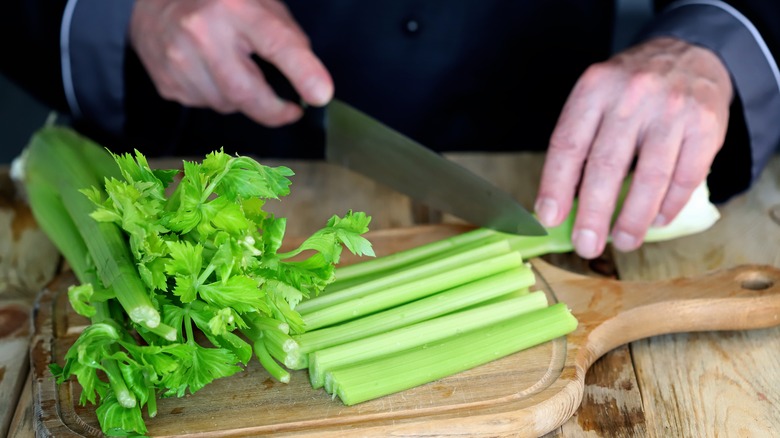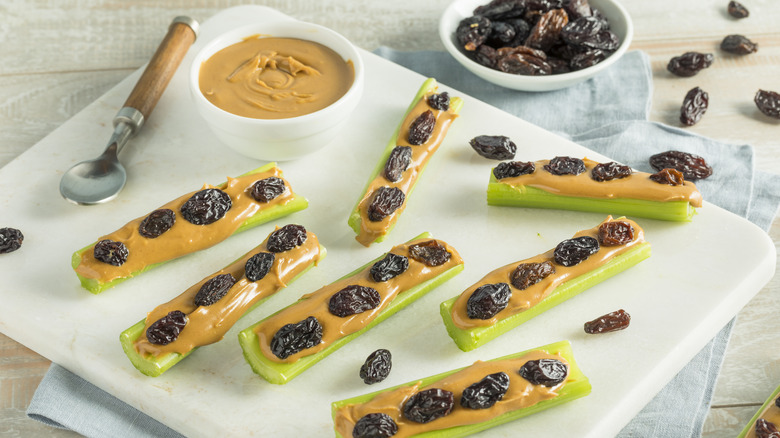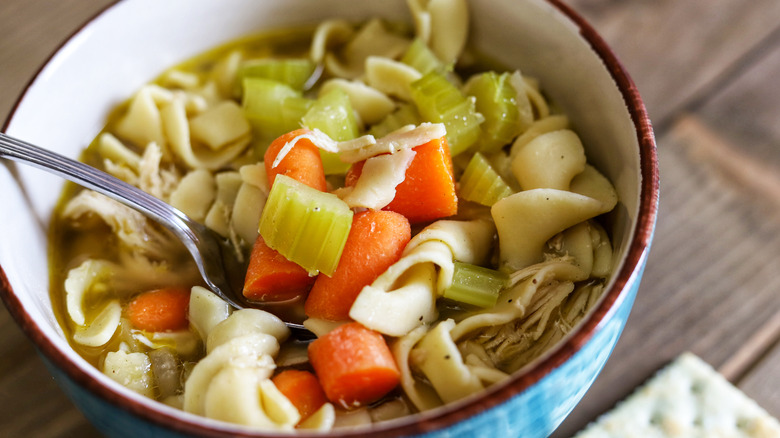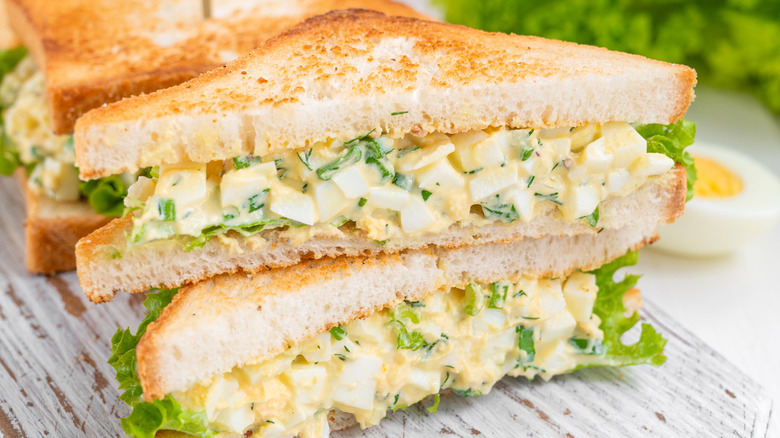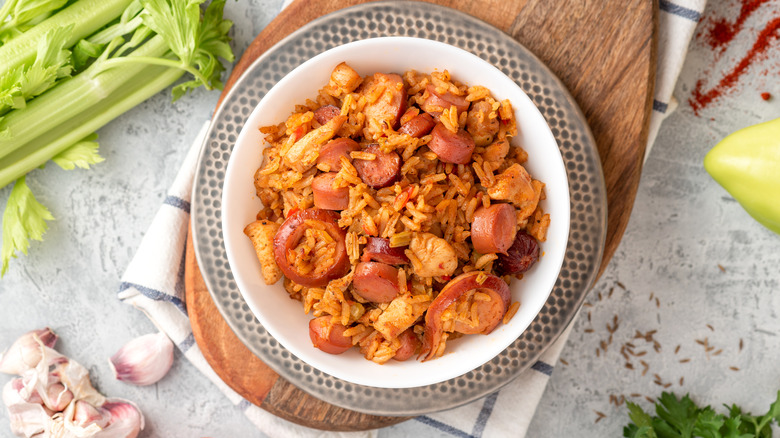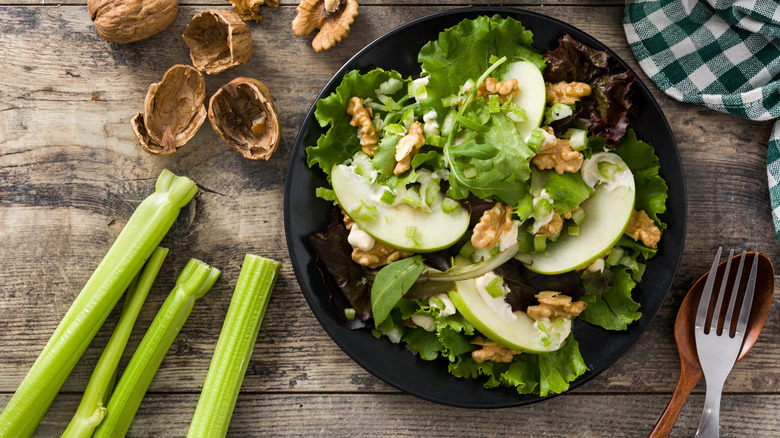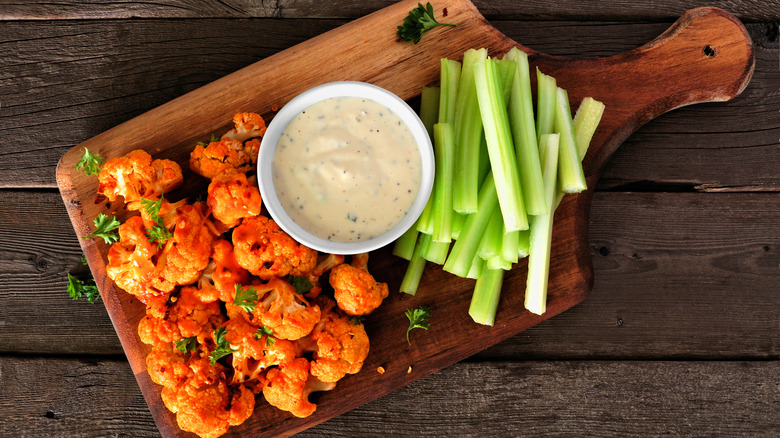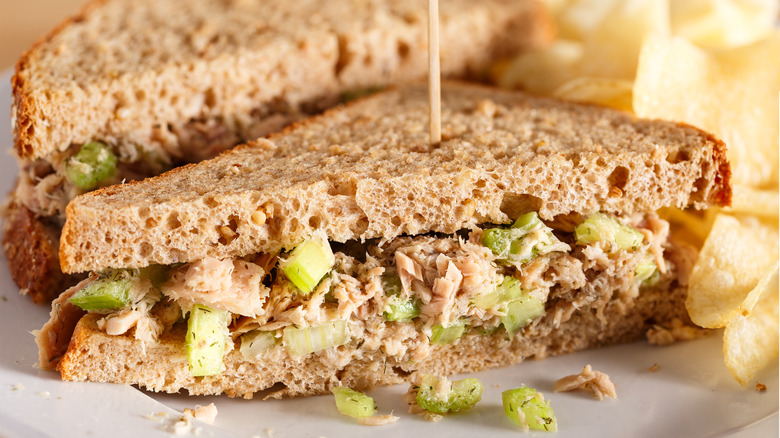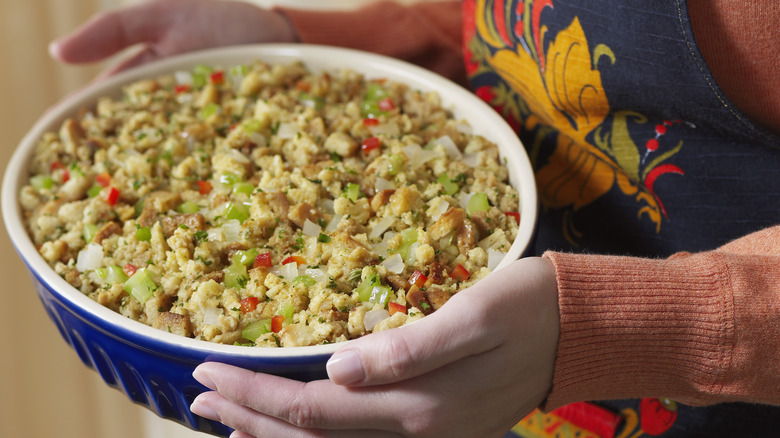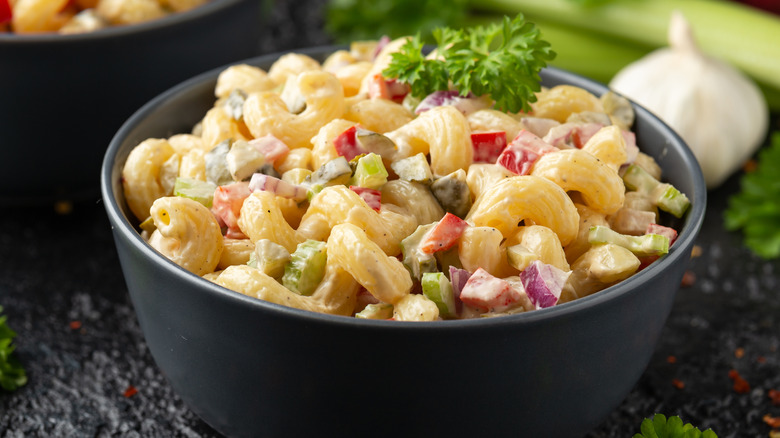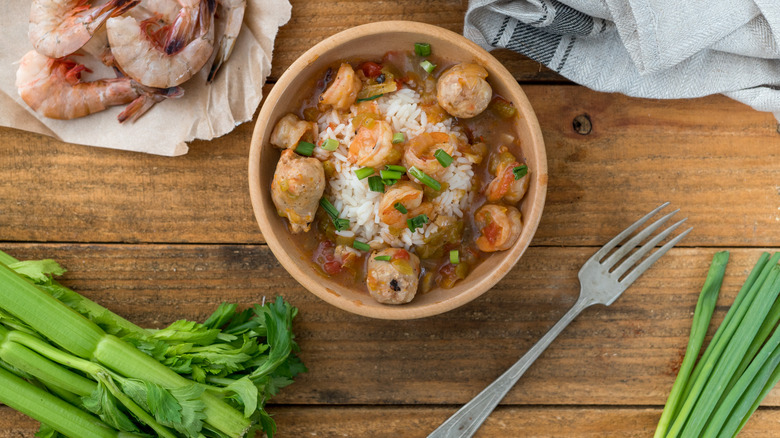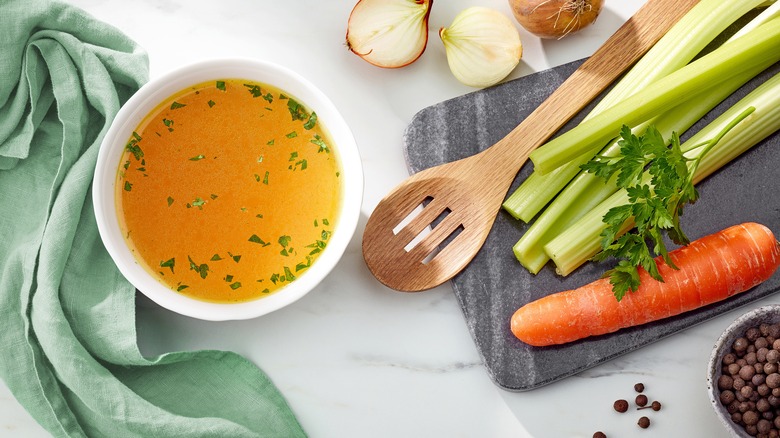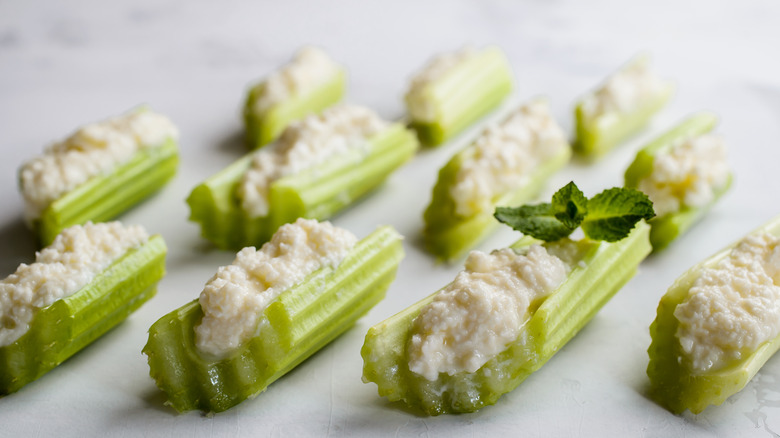13 Ways To Use Celery That You'll Actually Like
If celery doesn't spark joy for you, you're not alone. While some people can't wait to open a package of celery or start snacking, others are less than enthused about this vegetable and may find it too bitter or stringy to truly enjoy. In fact, a 2011 survey by Japan Today found that celery was one of the most disliked vegetables among adults.
However, even if you aren't a huge fan of the taste or texture of celery, including it in your diet can offer some benefits for your health. According to Healthline, celery can help decrease inflammation, aid in healthy digestion, and work to neutralize more acidic foods. Moreover, it is a great source of several vitamins, minerals, and antioxidants. The trick is to find a way that you'll actually be able to enjoy celery so that you can receive all of these health benefits that it has to offer. Read on to find some inspiration to help you incorporate celery into your diet and some of your favorite recipes!
1. Ants on a log
Ants on a log is a classic snack. You may have even heard of this recipe — or enjoyed it as a child — and simply forgotten about it as the years have passed. Celery is one of the key ingredients in this fun and healthy snack, acting as the "log" that the "ants" will sit on. But it's really the other two ingredients (peanut butter and raisins) that help make this a tasty treat while also working to balance out the taste of the celery.
Cut each stalk of celery in half (you can even use a vegetable peeler if you want to get rid of some of the stinginess to improve their texture) before smearing a good helping of peanut butter over each log. The more you use, the more you'll be able to hide the taste of the celery. Finally, add a few raisins to top each log. Using celery for this recipe is key — the snack just wouldn't be the same without the crunch that the celery offers. With the peanut butter and raisins, even those who are not huge fans of celery still find this to be a yummy recipe.
This is a particularly good snack to try if you're trying to increase your kids' veggie intake, and your young chefs can even help you make it. When you involve children in cooking, it can help encourage them to try new foods, while also improving their fine motor skills, computation, and communication skills — a real win, win!
2. Soups and stews
Many soup and stew recipes include celery and offer a perfect way to work this veggie into meals. The benefit of choosing one of these recipes is that many include directions to let the ingredients simmer on the stove for several hours. Letting the celery cook in the soup will help soften it, making it a bit easier to eat for those who don't enjoy how crunchy it is raw. Cooked celery also won't be as stringy as raw celery will. Another tip to minimize celery's taste when adding it to a soup or stew is to chop it up into really small pieces. This way, it will be more hidden, and you can focus more on all of the other ingredients as you enjoy your meal.
Some soups and stews where celery can be a welcome addition include Sicilian chicken soup, clam chowder, sausage and lentil soup, and beef stew. If you're feeling a bit more adventurous, you could also try to make cream of celery soup. While celery is, obviously, one of the key ingredients in this recipe and a bit less easy to hide, the potatoes, chicken broth, and heavy cream help balance its flavor.
3. Egg salad
Egg salad features hard-boiled eggs mashed with mayonnaise and (often) mustard. It can be used to make a delicious sandwich, but many people also enjoy just eating egg salad by itself, with some crackers, or as a dip for vegetables. Celery may or may not be included in your favorite egg salad recipe, but you may find that you actually enjoy how it takes this classic recipe up a notch.
With its delicious crunch, the celery can balance out the much softer texture of the smashed eggs, creating a real treat for your mouth. If you want to enjoy the crunch without getting overwhelmed by the taste of the celery, just take a little extra time to slice it into smaller pieces. Celery isn't the only ingredient that you may want to consider adding to ramp up your egg salad game. Some other popular additions include chopped pickles, chopped onions, bacon, tomatoes, or even avocado.
4. Jambalaya
Jambalaya is a flavorful and hearty dish that is very popular in New Orleans and the South. While recipes all contain rice, vegetables, and some meat, there are several different ways to customize this dish based on the specific ingredients you add to it. Most recipes feature sausage or chicken, but some use shrimp, venison, turkey, boar, crawfish, or other fish and meats.
Beyond switching up the meats that are used to make jambalaya, you can also customize which vegetables you add based on your tastes and preferences. However, there are three vegetables that are referred to as the "holy trinity" when it comes to making jambalaya — both Cajun and Creole styles. These are celery, onions, and bell peppers. As you could probably guess based on the nickname "holy trinity," these ingredients are seen as essential when making truly authentic jambalaya. Even if you're not a huge fan of celery, all of the other strong flavors found in jambalaya can help disguise its taste. Plus, as with soups and stews, you can simply chop it up into very small pieces if you want to further hide it within the dish.
5. Bloody Marys
Bloody Marys are a popular drink served with brunch. The cocktail famously comes garnished with a celery stalk, but that wasn't always the case. In 1970, a server in Chicago was reportedly searching for a straw to put in a Bloody Mary for one of his customers. He couldn't find a straw, but he saw some celery stalks lying about and decided to use one of them in place of the straw.
However, while adding celery to Bloody Marys started as more of an accident, the reason it has stuck around as a garnish for over 50 years isn't purely presentation: The flavor of the celery pairs nicely with the tomato juice in the cocktail. Even if you don't typically enjoy celery, you may want to try this flavor combination. It might surprise your taste buds. The cocktail's flavor can be enhanced with other additions as well, such as a rim of bacon salt.
6. Waldorf salad
You've probably heard of a Waldorf salad, but do you know exactly what it is? The main ingredients found in a Waldorf salad include celery, apples, and mayonnaise. However, you can find many variations that also incorporate grapes, walnuts, lemon juice, or other ingredients.
Waldorf salads got their name from the hotel in which they were first served: the Waldorf Astoria in New York City. In 1893, the Waldorf's executive chef Edouard Beauchamp and maître d'hôtel Oscar Tschirky created the salad to serve at a special charity ball being held at the hotel. They used just the three staple ingredients shared above: celery, apples, and mayonnaise. These ingredients were, in part, selected because they were readily available year-round.
Trying a Waldorf salad is a great way to work some celery into your meals. The mayonnaise (and now other dressings) can help temper the bitterness of the celery. Plus, the crunchy apples, juicy grapes, and savory nuts can also help to make the taste of the celery less noticeable.
7. On the side with Buffalo wings
Another way to use celery and make it more enjoyable to eat is to serve it on the side with Buffalo wings. These wings can be hot and spicy, but having a few bites of celery between wings or once you've finished can help cool the heat. Even if you're someone who enjoys really spicy foods, you may still appreciate cleansing your mouth after the wings with some cool and crispy celery. Plus, the added crunch it offers can also help to perfectly round out the meal. Most Buffalo wings are served with blue cheese dressing, and dipping the celery in the dressing is also a popular choice among wing-eaters. It can amplify the power of the celery for an even more enjoyable experience.
While serving buffalo wings with celery and blue cheese is so commonplace nowadays, there is an interesting story of how the tradition started. Buffalo wings were first "invented" in 1964. A woman named Teressa Bellissimo created the spicy recipe for the wings and paired it with a side of celery and blue cheese dressing. However, she didn't choose these accompaniments for any particular reason; rather, they were simply what was available at the time in the kitchen.
8. Tuna salad
A tuna salad sandwich can be a tasty treat to enjoy with lunch. However, sometimes it can just seem too soft and plain when you simply mix the tuna fish with some mayonnaise or even a little bit of mustard. Enter celery. Adding a little celery to your tuna salad can turn a rather bland meal into a delectable treat. As with some of the other ideas shared above, celery can give tuna salad a little crunch, which may be just what your sandwich needs.
If you're not a fan of huge chunks of raw celery in your food, don't worry. There are no requirements stating how big each piece of celery needs to be — even smaller pieces will still offer a little crunch without altering the taste of the tuna very much. Just use the tip of your knife to cut the stalk lengthwise into thin sections. Then, you can slice each section to end up with tiny pieces to add to your tuna salad recipe.
9. Stuffing
Don't let your next holiday meal fall short. Adding celery to your stuffing is a step you may not want to skip. Not only is it a traditional ingredient that guests will be searching for when enjoying Thanksgiving dinner or another meal with you, but it adds to the recipe's flavor profile. Many stuffing recipes also feature onion, and sometimes carrots, alongside the celery.
However, before you simply start chopping up the celery and adding it to your stuffing mix, you'll want to properly prepare it. Start by finely chopping the celery — no one's going to want a huge hunk of celery in their stuffing. Then, sauté the celery (along with the onions and carrots) in a frying pan with melted butter. Give the veggies plenty of time to cook and get tender. Then, they'll be ready to combine with the cubed bread or cornbread and the various seasonings you're planning to use. Precooking the celery is important because it will help make sure that it is not too hard in the finished product.
10. Macaroni salad
There are many different recipe variations for making macaroni salad. Generally speaking, it's made using cooked macaroni noodles mixed with mayonnaise and mustard. Depending on the recipe you follow, different vegetables may be added to the mix, including onions, bell peppers, carrots, peas, tomatoes, and, of course, celery. Once prepared, the pasta mixture is chilled and then served cold.
While you can easily omit celery from a macaroni salad recipe, this ingredient can really add to the overall taste and texture of the dish. The deliciously crunchy and cooling celery nicely complements the softer macaroni noodles. Its taste also pairs nicely with the mayonnaise and mustard mixture, along with a variety of other veggies that you might choose to add to your salad. Macaroni salad can make a perfect side for summer barbecues and gatherings. Because it is chilled before serving, it can be quite refreshing on a warm summer day.
11. Gumbo
Gumbo is a type of stew made using different types of meat and vegetables. It is another dish which is associated with New Orleans and Louisiana. However, despite what many think, it did not originate from this region. Historians are split on where the dish comes from. Some think it evolved from a Native American Choctaw stew, while others think French bouillabaisse (fish stew) was slowly changed to give us the gumbo we know today. Another theory is that gumbo came from West Africa because of the similarity between the term "gumbo" and "gombo," the West African word for okra (which was featured in many early gumbo recipes).
Regardless of where gumbo originated from and got its name, it is a thick and filling stew that can be made using a variety of ingredients (namely meats and vegetables). Like jambalaya, the holy trinity of celery, onions, and green peppers are featured in most recipes. As with other stews, the celery can enhance the overall flavor. And, if you don't want an overpowering taste of celery in each bite, just remember to finely chop the stalks and give them plenty of time to soften and cook with the other ingredients.
12. Bone broth and stock
Sure, you can pick up a can of broth or chicken stock at the store, but it simply pales in comparison to making your own. Homemade broths and stocks can be a tasty addition to many home-cooked meals. Moreover, they are an inexpensive yet very nutrient-dense food that can have a variety of benefits, from improving digestion to easing joint or arthritis symptoms, according to Low Tox Life.
Celery is a key ingredient in stocks and broths. As with other recipes, it works with the onions, carrots, and other vegetables to flavor the stock. And, since you won't actually be eating any of the veggies you use to make the broth, you won't even need to chew on the celery if its texture is what you really don't like. You can also use all the parts of the celery stalk, including the leaves, to make broths and stocks. This is because you'll be straining them from the finished product anyway, so they'll just be contributing to the flavor.
13. Halloween mummy snacks
Do you have some picky little eaters at home that never seem to want to eat their vegetables? Children should eat between four and five servings of vegetables each day. This can be a real challenge for some, but one thing you can do is to make eating celery and other vegetables more fun and exciting. Offering different vegetables with a variety of tastes, textures, and appearances can make them more appealing to eat. Another idea is to cut the vegetables up and combine them together to make faces or fun scenes on plates. This way, children aren't eating a piece of celery; they're eating a raft going down a river of blueberries. And, they aren't simply eating broccoli, they're chomping on the tree next to the house made with celery stalks and carrots.
Another idea that is perfect for Halloween, but also fun for any time of the year, is to make cute mummy snacks. This spooky snack is made with celery stalks, cream cheese, ham, and cranberries. The stalks are filled with the cream cheese. Thin slices of ham are placed on top (resembling a mummy's wrappings), and pieces of cranberries serve as "eyes." Now you have a healthy and fun snack for your kids to enjoy (though you might want to try one of these mummies, too).
